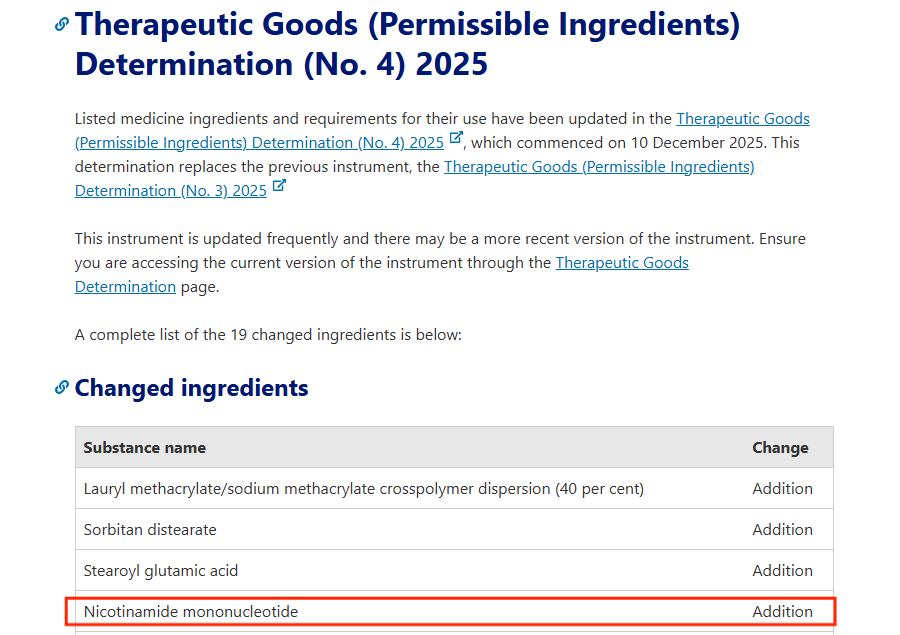Nicotinamide mononucleotide (NMN) has long attracted global attention as a promising ingredient in health supplements and functional foods, due to its potential role in supporting cellular metabolism, healthy aging, and overall well-being.
In recent weeks, key regulatory developments driving in major markets have brought clarity to NMN's legal status, creating new opportunities for the supplement industry.
On December 9, 2025, the U.S. Food and Drug Administration (FDA) published a response letter on Regulations.gov, addressing submissions by Chinese company SyncoZymes (Shanghai) Co., Ltd. regarding β-nicotinamide mononucleotide (NMN).

*Image source: Regulations.gov
The FDA reinstated NMN as a dietary supplement, reversing its prior interpretation that had excluded the ingredient under the drug preclusion clause of the Dietary Supplement Health and Education Act (DSHEA).
This determination followed the FDA's review of SyncoZymes's submissions (NDIN 1240 and NDIN 1247) and included the withdrawal of the 2022 alternative response letter and the restoration of the original responses from 2022, now publicly available on Regulations.gov.
Industry observers described this as a historic breakthrough, ending nearly three years of regulatory uncertainty. The decision not only resolves NMN's compliance status but also clarifies the application of DSHEA's drug exclusion provision, creating precedent for other emerging ingredients and reinforcing broader consumer access in the U.S. market.
Following the U.S. update, Australia's Therapeutic Goods Administration (TGA) on December 10, 2025, added NMN to the permissible ingredient list for listed complementary medicines. This approval establishes a clear compliance pathway for NMN-containing formulations under Australian law.

*Image source: TGA
The TGA also granted a two-year market exclusivity period for NMN (December 10, 2025 – December 10, 2027), during which the use of NMN in listed medicines is reserved for the applicant(SyncoZymes). This provides both legal certainty and a temporary competitive advantage in the Australian market, reinforcing NMN's recognized status as a safe and regulated supplement ingredient.
Globally, NMN is lawfully used in dietary supplements or listed medicines in markets such as the United States, Japan, Canada, Australia (including New Zealand). In the European Union, however, despite multiple novel food applications for NMN having been submitted, no authorization has been granted so far; enforcement actions, including repeated RASFF notifications in recent years, reflect strict regulatory control while these applications remain under review.
In China, NMN is currently permitted for use as a cosmetic ingredient, with 12 new cosmetic ingredient notifications having been completed so far.
In contrast, its use in foods in China is subject to approval as either a new food ingredient or a new food additive variety. To date, the National Health Commission of China (NHC) has issued a formal decision denying administrative approval for NMN as a new food additive, and as a result, NMN remains prohibited for use in foods and dietary supplements in China.
At present, NMN-containing dietary supplements and functional foods imported from overseas may be sold in China exclusively through cross-border e-commerce (CBEC) channels, where marketing claims are strictly regulated to prevent misleading or non-compliant promotion.
The Opinions on Further Strengthening Full-Chain Food Safety Supervision and recent enforcement inspections indicate that authorities are moving toward risk-based oversight of imported foods and CBEC products. Proposed measures, including a negative list for high-risk imported products and stricter recall obligations, suggest that some hot functional ingredients like silybum marianum could face restrictions on sales via bonded warehouses, potentially impacting existing CBEC channels and long-term market access.
Companies planning to sell NMN in China should closely monitor regulatory developments, ensure full compliance of both ingredients and finished products, and prepare for potential changes to cross-border import rules to safeguard their market presence.
ZMUni Compliance Center provides professional support for companies planning to submit applications for new food ingredients or new food additive varieties in China, including application feasibility analysis, dossier preparation, safety assessment reports, and tailored regulatory consulting. For assistance, please feel free to contact us at info@zmuni.com.
https://www.regulations.gov/document/FDA-2023-P-0872-2754
https://www.npanational.org/news/fda-reinstates-nmn-as-dietary-supplement-after-npa-lawsuit/